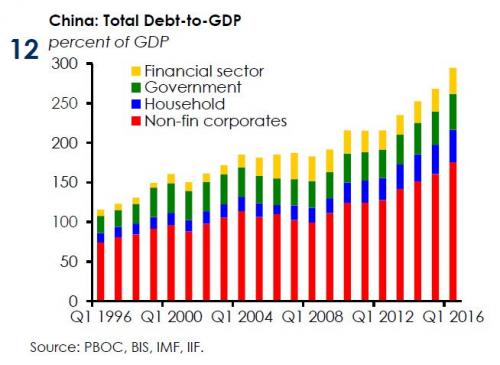Not even last night’s Moody’s credit downgrade of China – the first since 1989 – could dent the global stock rally which has pushed global stock prices to all time highs. After initially sliding, regional stocks and emerging Asian currencies pared early losses following the unexpected downgrade of China, taking their cue from the “sudden reversal” of the Shanghai Composite Index, which some speculated saw the latest intervention of the “national team.”

Moody’s action on China briefly rattled Asian markets, but against a backdrop of strengthening global growth and the impending release of minutes from the Federal Reserve’s latest meeting, investors appeared to quickly move on. MSCI’s broadest index of Asia-Pacific shares outside Japan was unchanged while Japan’s Nikkei stock index ended 0.7 percent higher.
The Shanghai Composite gained 0.1% at the close, reversing an early decline of 1%, while the offshore yuan inched up. As reported last night, the major overnight catalyst in Asia was Moody’s downgrade of China’s credit rating to A1 from Aa3 in early Asia trading, citing a worsening outlook for the nation’s financial strength – in the end of the Chinese session it had little impact, aside from another steep selloff in iron ore, which traded nearly limit down. The downgrade impact on regional currencies was likewise limited as Asia’s economic growth is seen to be improving and there are still positive stories such as S&P’s upgrade of Indonesia’s rating last week.
By the end of the session, nobody even remembered China had been downgraded: the Shanghai Composite rose 0.1 percent, reversing a drop of 1.3 percent. The Hang Seng also ended higher after an earlier decline of 0.4 percent. Japan’s Topix index climbed 0.6 percent, while Indonesia’s benchmark index slumped 0.7 percent. The Australian dollar slipped 0.1 percent, paring a steeper drop of as much as 0.5 percent.
Away from Asia, European stocks rose and U.S. equity futures and the dollar both steadied. The Stoxx Europe 600 Index climbed a second day, but struggled to gain momentum as miners slumped after China’s downgrade. That triggered declines across copper, nickel, zinc and iron ore. The British pound strengthened after two days of losses, even as Prime Minister Theresa May warned that further terrorist attacks could be imminent.
“There’s been a cautious start in Europe this morning with stocks in the red following a downgrade in the Chinese credit rating from Moody’s,” said David Cheetham, chief market analyst at brokerage XTB. “After being very much at the front and center of global risk sentiment at the beginning of last year, the Chinese slowdown story has been almost forgotten, with politics throughout Europe and the U.S. taking the limelight.”
S&P500 futures were little changed as investors awaited economic data and earnings reports, while volatility dropped for a fifth day. S&P 500 contracts expiring in June added less than 0.1% to 2,398.5 at 6:30 a.m. in New York.
Crude extended gains a sixth day as OPEC prepared for Thursday’s key meeting in Vienna, and where an announcement of a 9 month productin cut extension now is fully priced in.

In currencies, the dollar was little changed against most of its peers and Treasury yields were steady before the U.S. Federal Reserve releases later Wednesday the minutes of its May 3 policy meeting. With Fed due to release its May meeting minutes, “markets are ready to catch any clue regarding the likelihood of an interest- rate hike at the FOMC’s June meeting,†writes Ipek Ozkardeskaya, senior analyst at London Capital Group. Fed Bank of Philadelphia President Patrick Harker said June “is a distinct possibility†for the U.S. central bank’s second interest-rate increase of 2017.
While equities quickly forgot the downgrade of China, the world’s top user of materials, industrial metals were far more bruised, as nickel slumped 1.9% and copper fell 0.6%. Iron ore futures dropped 4.7%. West Texas oil rose 0.2 percent to $51.56 a barrel, adding to a five-day advance ahead of tomorrow’s OPEC meeting. Gold added 0.1 percent to $1,252.30 an ounce, after dropping 0.8 percent on Tuesday.
Elsewhere the Australian dollar fell and the yen pared losses against the U.S. currency after Moody’s Investors Service cut its rating on China’s debt for the first time in almost three decades. The euro was little changed ahead of the Fed minutes, even as ECB policy makers warned of the dangers of the ‘ripple effect’ from the house price boom and ‘significant’ bond risks spurring increased debt concerns.
In rates, the yield on 10-year Treasury notes fell less than one basis point to 2.27 percent. Bonds fell during the previous four days. Yields on benchmark French, German and British bonds all dropped two basis points.
Today investors await the minutes of the U.S. Federal Reserve’s latest policy meeting, scheduled to be released at 2pm. Fed funds futures show that traders now see a 75% chance that the U.S. central bank would will raise interest rates at its June meeting. “Our U.S. economists expect the minutes to come down on the hawkish side and continue to expect the Fed to hike in June and September and announce balance sheet reduction in December,” Citi analysts wrote on Wednesday.
Bulletin Headline Summary from RanSquawk
- Equities fail to find firm direction and seemingly looking through China’s sovereign downgrade as Moody’s offers little in the way of any surprises.
- A very quiet morning in FX with focus on the FOMC minutes, alongside the OPEC/Non-OPEC meeting.
- Looking ahead, highlights include US Building Permits, Existing Home Sales, DoE Inventories, FOMC Minutes, BoC Rate Decision, ECB’s Praet and Draghi

